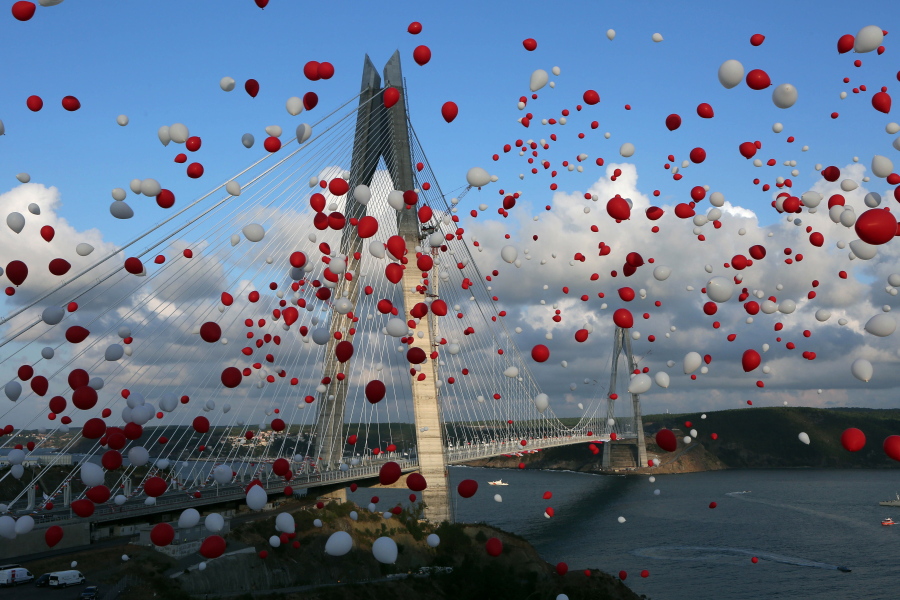On Friday, Turkish President Recep Tayyip Erdogan ceremonially opened Istanbul’s third bridge spanning the Bosporus, the strait that runs through Turkey’s biggest city and separates the continental land masses of Asia and Europe. The bridge is the $3 billion centerpiece of a vast series of infrastructure projects planned by Erdogan and the country’s ruling government in a bid to boost a flagging economy and clear up traffic congestion across a crammed metropolis.
Perched at the entrance to the Black Sea, it’s billed as a the world’s widest suspension bridge, with eight highway lanes for vehicles and two rail lines. “This bridge puts Turkey among the world leaders,” declared Michel Virlogeux, a French architect who was one of the lead designers of the project. “It’s the most spectacular to have been built in the last years.”
The structure does have its critics, though. Rights groups complained that the government didn’t issue a proper environmental report regarding the effects of the project. They fear further deforestation in the northern environs of Istanbul, a teeming city that’s starved of green space.
“The traffic problem that could not be solved by two bridges will not be solved by a third,” an activist with Northern Forests Defense, a local group, told the National. “Bridges do not decrease traffic. They create their own traffic because bridges transport cars, not passengers.”
And then there’s the bridge’s name. It’s called the Yavuz Sultan Selim Bridge in honor of the ninth Ottoman emperor, Selim I, a monarch who earned the sobriquet Selim the Grim for his years of military campaigning and severe rule.
In 2013, when the name was announced at a groundbreaking ceremony, it sparked a great deal of controversy. Selim I is famed for his conquests to the east in the early 16th century, extending the Ottoman Empire’s dominion over Egypt and the Holy Lands while also pushing against the Safavid Empire in what’s now Iran.
The decisive Ottoman victory over the Safavids in the 1514 Battle of Chaldiran in some sense prefigured much of the map of the modern Middle East.
But Selim’s wars had a sectarian dimension. In particular, the emperor is believed to have ordered the slaughter of tens of thousands of Alevis, a minority sect linked to Shiism and steeped in Sufi and rural Anatolian traditions. In the eyes of some Ottoman rulers, Alevis were a heretical sect and potential loyalists to foreign Shiite powers (a similar logic informed Ottoman persecution and slaughter of Christian Armenians a hundred years ago).
According to Alevi folklore, some 40,000 practicing Alevis were killed by Selim’s forces, though later Turkish historians dispute that figure.
Whatever the case, the move to name such a commanding edifice for the emperor led to protests from Alevis, who make up 10 to 15 percent of Turkey’s population. The minority group tends to vote for leftist or secularist parties in opposition to Erdogan’s ruling Justice and Development Party, which commands the support of much of Turkey’s conservative Sunni heartland.
To many Alevis, the bridge’s proposed name seemed a mark of disrespect and indifference to their history of marginalization and discrimination. One opposition politician suggested the name be changed to Sultan Pir Abdal, a 15th-century Alevi poet. In an overt bid for national unity, Kemal Kilicdaroglu, head of the Republican People’s Party, Turkey’s leading opposition group, suggested the bridge be named after Mustafa Kemal Ataturk, the republic’s founder.
But Erdogan is interested in creating a legacy that perhaps even transcends that of Ataturk and has sought, in ways big and small, to rehabilitate or resurrect Ottoman history to suit his narrative in power. In the wake of last month’s failed coup attempt, the debate over the bridge’s name almost seems quaint. Yavuz Sultan Selim, it seems, stuck.



